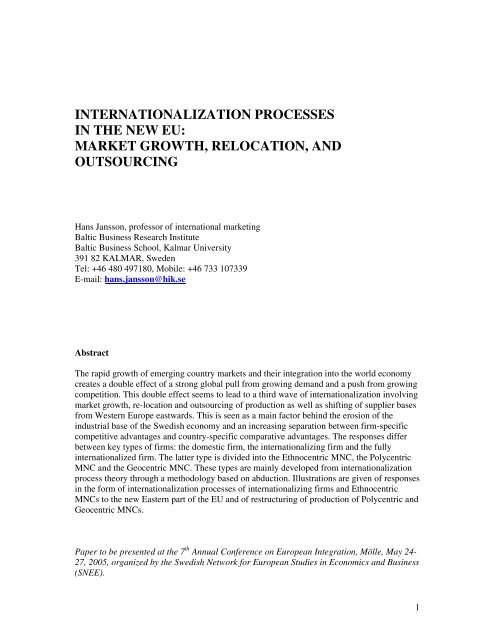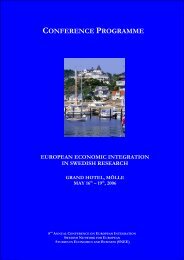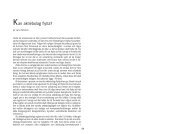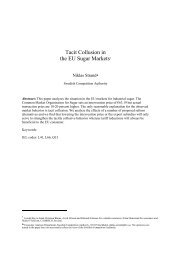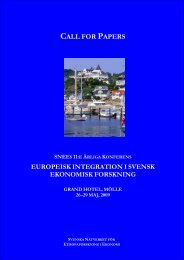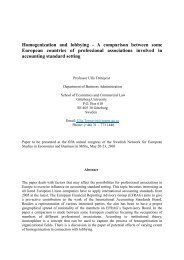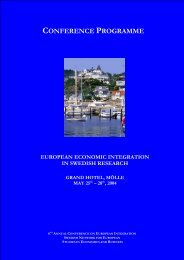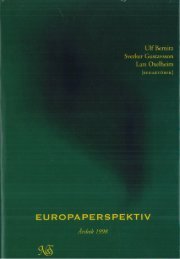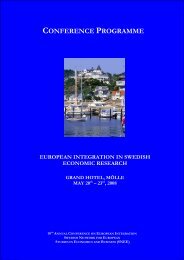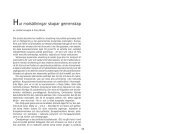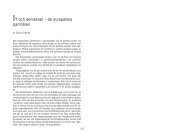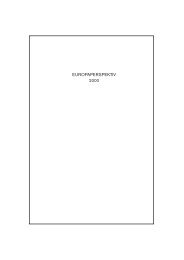INTERNATIONALIZATION PROCESSES IN THE NEW EU ... - SNEE
INTERNATIONALIZATION PROCESSES IN THE NEW EU ... - SNEE
INTERNATIONALIZATION PROCESSES IN THE NEW EU ... - SNEE
Create successful ePaper yourself
Turn your PDF publications into a flip-book with our unique Google optimized e-Paper software.
<strong><strong>IN</strong>TERNATIONALIZATION</strong> <strong>PROCESSES</strong><br />
<strong>IN</strong> <strong>THE</strong> <strong>NEW</strong> <strong>EU</strong>:<br />
MARKET GROWTH, RELOCATION, AND<br />
OUTSOURC<strong>IN</strong>G<br />
Hans Jansson, professor of international marketing<br />
Baltic Business Research Institute<br />
Baltic Business School, Kalmar University<br />
391 82 KALMAR, Sweden<br />
Tel: +46 480 497180, Mobile: +46 733 107339<br />
E-mail: hans.jansson@hik.se<br />
Abstract<br />
The rapid growth of emerging country markets and their integration into the world economy<br />
creates a double effect of a strong global pull from growing demand and a push from growing<br />
competition. This double effect seems to lead to a third wave of internationalization involving<br />
market growth, re-location and outsourcing of production as well as shifting of supplier bases<br />
from Western Europe eastwards. This is seen as a main factor behind the erosion of the<br />
industrial base of the Swedish economy and an increasing separation between firm-specific<br />
competitive advantages and country-specific comparative advantages. The responses differ<br />
between key types of firms: the domestic firm, the internationalizing firm and the fully<br />
internationalized firm. The latter type is divided into the Ethnocentric MNC, the Polycentric<br />
MNC and the Geocentric MNC. These types are mainly developed from internationalization<br />
process theory through a methodology based on abduction. Illustrations are given of responses<br />
in the form of internationalization processes of internationalizing firms and Ethnocentric<br />
MNCs to the new Eastern part of the <strong>EU</strong> and of restructuring of production of Polycentric and<br />
Geocentric MNCs.<br />
Paper to be presented at the 7 th Annual Conference on European Integration, Mölle, May 24-<br />
27, 2005, organized by the Swedish Network for European Studies in Economics and Business<br />
(<strong>SNEE</strong>).<br />
1
<strong>IN</strong>TRODUCTION<br />
The rapid growth of emerging country markets and their integration into the world economy is<br />
drastically re-arranging the competitive forces for firms and economies. Almost every day we<br />
are learning about Swedish firms moving their production or outsourcing it to Central and<br />
Eastern Europe (CEE), China, or India. One major consequence is that the strong industrial<br />
base of the Swedish economy seems to diminishing rapidly as new jobs are not created at the<br />
same pace as jobs are lost. 1 Swedish firms seem to create more jobs abroad than in Sweden at<br />
the same time as more jobs are exported than imported. R&D investments and the number of<br />
new companies are going down. The Swedish economy does not seem to be able to sustain its<br />
comparative advantages built on capital/knowledge intensive industries, not being able any<br />
longer to gain from globalization to the same extent as before. One reason is that major<br />
markets in CEE have been integrated into the common European market. Another reason is the<br />
rapidly growing markets in China and India as well as intensified competition from companies<br />
in these countries. China has emerged as the “factory of the world” and India as the “global<br />
software centre”. This has created new low cost production bases. But most importantly, India<br />
and China in particular, have upgraded their competitive advantages to industries, where<br />
Western mature industrial countries traditionally have comparative advantages, e.g. hi tech<br />
industries. This creates a double effect of a strong global pull from growing demand and a push<br />
from growing competition that dramatizes the competitive situation in Northern Europe<br />
considerably, increasing the risk of Swedish firms being outperformed by foreign firms, both<br />
large and small. However, there seem to be a contradiction between country-specific<br />
advantages and firm-specific advantages. The Swedish economy might be losing competitive<br />
strength but not necessarily the Swedish companies. An indication of this is the decreasing<br />
number of jobs in Sweden in comparison with the increasing number of jobs at Swedish<br />
companies abroad and for these companies as a whole.<br />
This contradiction and new competitive situation is not enough to study at the macro level,<br />
treating the firm as a black box. In opening this box, it is found that the double effect<br />
mentioned above seems to result in a third wave of internationalization of firms with a low<br />
degree of internationalization, particularly small and medium-sized enterprises (SMEs), and to<br />
a new phase of re-structuring of already internationalized firms. Due to how far they have<br />
come in the internationalization process, firms respond differently to this new situation. At one<br />
extreme is found firms that have completed the internationalization process and now are truly<br />
global firms or multinational corporations (MNCs). Such a company needs to restructure on a<br />
global basis, innovating new products and businesses, being less dependent on the Swedish<br />
home base. Here, there might be a difference between the firm-specific competitive advantage<br />
and the country-specific advantage of the Swedish economy. At the other extreme is found the<br />
still non-internationalized firm: the domestic market oriented SME. Firms at the early<br />
internationalization stages are slower to respond, because they lack resources for and<br />
experience of international trade and investment and have a traditional home-market focus,<br />
being late comers on the international scene. For such firms there is less difference between<br />
firm-specific competitive advantage and country-specific advantage, since Sweden is their<br />
strategic base. This means that their competitive advantage in international markets is highly<br />
dependent upon how competitive Sweden is as a nation. This competitiveness might also vary<br />
between regions in a country, where some regions are more competitive than others, being a<br />
kind of region-specific advantage.<br />
Some general trends in how firms respond to this internationalization challenge seem to be:<br />
2
* More home-market oriented SMEs are internationalizing their business operations.<br />
* Internationally experienced companies change their internationalization behaviour.<br />
Traditional internationalization processes take place on mature markets: European firms first<br />
went to mature markets in Europe and later to North America, and finally to emerging markets<br />
in Latin America and Asia. The new situation implies a more mixed internationalization<br />
process.<br />
* Internationalization processes are becoming more complex. Traditional internationalization<br />
processes are sales based and concern exports and foreign direct investment (FDI) in new<br />
markets. The growing importance of outsourcing results in increasing reliance on foreign<br />
supplier markets, imports and the internationalization of supplies. This has earlier been a vital<br />
issue in certain industries and regions since the 1970’s, e.g. for clothing and electronic industry<br />
in Asia. But it is now diffused to many more industries and firms. Traditionally, the location of<br />
production is a consequence of the gradual build-up of the foreign customer market. Such<br />
internationalization processes are still valid due to the rapidly growing markets in CEE and<br />
Asia. But lower costs for both blue and white collar workers increase internationalization of<br />
production, even making firms to only internationalise production without any direct linkage to<br />
sales.<br />
* Increased international competition. More competitors from emerging markets in Eastern<br />
Europe, China and India make internationalization processes more difficult, e.g. home-market<br />
oriented SMEs are facing a larger risk of being put out of business due to re-location of<br />
production.<br />
ISSUES<br />
Responses to environmental changes vary between the firms. The accession of ECE countries<br />
to the <strong>EU</strong>, e.g., creates opportunities for going international for many European SMEs. For the<br />
internationalizing firm, it could involve a re-positioning of its international marketing efforts,<br />
while it might lead to restructuring of production for the internationalized firm, or it being able<br />
to take advantage of lower production costs in Europe rather than Asia and therefore outsource<br />
there. To characterize these types of firms more, it is necessary to look closer at how they<br />
internationalize or have been internationalized, the key factor being how they build<br />
international experience. This is done by developing internationalization process theory<br />
further. This implies that such processes are mainly seen to be knowledge-based, and where<br />
innovation strength and organizational learning are critical for future growth.<br />
This paper is built on the assumption derived from earlier IB research that how firms respond<br />
to changes in international markets largely depends on where in the internationalization<br />
process they are found, i.e. their degree of internationalization. To know more about the<br />
response to the new situation discussed above, internationalization process theory is developed<br />
in four major ways:<br />
1. Since re-location and restructuring of production plays a key role in this third wave of<br />
internationalization and new phase of global restructuring, it is important to clarify and develop<br />
the role of this activity in the internationalization process.<br />
2. This increased importance of production in internationalization is part of a more complex<br />
internationalization process, which is better understood if it is disaggregated into the different<br />
activities of the value chain, e.g. production, sales, and purchasing.<br />
3. Fixing an end to the internationalization process. A lot of research has been devoted to the<br />
beginning of the process, while very little has been said about its end. It is reasonable to<br />
establish a finish line for this process, which is about how firms are internationalizing from<br />
3
scratch to some final stage. The idea of a fully internationalized firm is developed in the<br />
paper. This does not mean the end of internationalization process theory. Quite the contrary of<br />
that. It is developed to be valid for a broader range of internationalization issues including<br />
both internationalizing and internationalized firms.<br />
4. As indicated above, internationalizing issues today largely involve emerging markets, where<br />
Western firms face a very different context and the critical importance of doing business in<br />
networks. These aspects are integrated into the internationalization process theory below. Even<br />
if there are numerous studies on internationalization processes, the new situation of<br />
internationalizing to emerging markets has not been much studied.<br />
METHODOLOGY<br />
The methodological strategy behind this research is mainly abductive, being a mix of<br />
deduction and induction (Alvesson & Sköldberg, 1994; Jansson, 1994a). It rests on the limited<br />
possibilities of generalization of various theories in time and space. The purpose is theoretical<br />
development, where the empirical support of a theory is continuously assessed, or, inversely, a<br />
reality’s theoretical support investigated, through the matching of theories with realities. Such<br />
a process either has a deductive or an inductive starting-point. The deductively angled<br />
processes are theory-led, while inductive approaches are characterized by the continuous<br />
abstraction of empirical realities. The results presented in this paper come from a research<br />
process, which started from a more preliminary frame of reference, using the case-study<br />
approach (e.g. Merriam, 1998; Yin, 1991). This framework has been continuously refined<br />
through changing perspectives between deductive and inductive approaches. The final aim is to<br />
create a solid theoretical and empirical base at the same time as strengthening the practical<br />
validation of the research, by making the results relevant for organizations and society. Inter<br />
alia, embedded case study methods are used to integrate qualitative and quantitative knowledge<br />
(Scholz & Tietje, 2002).<br />
<strong>THE</strong> <strong>THE</strong>ORETICAL FRAMEWORK<br />
Based on their international experience, firms are grouped into five major categories. This<br />
grouping is based on research on internationalization processes and MNCs.<br />
* The Domestic firm. This is a company operating in the home market that has not yet started<br />
to internationalize and therefore is no MNC.<br />
* The Internationalizing firm. This firm is internationalizing its activities in the value chain and<br />
is found somewhere in-between the home market and the fully internationalized firm, being an<br />
immature MNC. The internationalization process model is mostly relevant for this type of firm,<br />
as it passes through its various stages. In Sweden today, these firms are SMEs that either have<br />
a potential to internationalize further or start to internationalize. They will be illustrated below<br />
based on a recent study of internationalizing SMEs in Kalmar county.<br />
* The Internationalized firm. This is a grown-up MNC that has reached the end of the<br />
internationalization process and can therefore be considered to be a fully internationalized<br />
firm. There are three major types of such firms:<br />
- The Ethnocentric MNC, which spatial focus is the home base, being its strategic base. There<br />
this MNC has most of its key activities, including production, R&D and HQ. The<br />
organizational infrastructure of this firm is characterized as a global organization or<br />
multinational organization (Barlett & Ghoshal, 1989). Many small and medium-sized MNCs<br />
located in the Kalmar county fall under this category, which will be discussed further below.<br />
4
- The Polycentric MNC, which has strategic bases spread over the globe, still having the major<br />
base in the home country: production, R&D activities and Group HQ. But major business areas<br />
are often located to other parts of the world. The international organization of the MNC<br />
approximates the organizational infrastructure of this firm. For this firm, the value chain is<br />
often disaggregated and reengineered on a global basis. Volvo, SAAB, Scania, or other big<br />
MNCs in the vehicle industry are good examples of this kind of firm, which will be developed<br />
more below.<br />
- The Geocentric MNC, which is global in the true meaning of the word, since there is no<br />
strategic base left in the home country. It is not traditionally bound to any particular place,<br />
looking at the world as one big market, therefore being located in the most suitable place in<br />
relation to its activities. That includes its headquarters. This type of firm can be said to<br />
represent the end of internationalization in the way that it strategically has left its original<br />
home base and is a fully global firm. It coincides with the arise of “the Regioncentric MNC”.<br />
It operates on a global basis for all business activities and has a global firm infrastructure,<br />
which is best characterized to follow the principles of the transnational organization. There is<br />
either a continentally based headquarters or one virtual global headquarters for the worldscale<br />
operations. Home is everywhere or in no particular place.<br />
Internationalization Processes<br />
Internationalization processes take place in a stepwise manner (Jansson, 1989; 1994b; 2005).<br />
Companies commit themselves through a gradual learning process. Learning is incremental<br />
and takes place by doing. Firms learn about doing business abroad, e.g. about the conditions in<br />
particular markets. Companies tend first to establish themselves in geographically and<br />
culturally proximate markets and increase their commitment more and more, starting with<br />
agents, and passing through sales companies to manufacturing companies (Johanson &<br />
Wiedersheim-Paul, 1975; Johanson & Vahlne, 1977). This has mainly been studied for MNCs<br />
but also for SMEs (Hohenthal, 2001). Research on the export of mainly North American both<br />
small and large companies have reached similar results (Bilkey, 1978; Cavusgil (1980); Reid<br />
(1981), Czinkota (1982). However, ‘Born globals’ or ‘International new ventures’ (that are<br />
international from inception) tend to follow another pattern (Oviatt & McDougall, 1994;<br />
Madsen & Servais, 1997, Sharma & Blomstermo, 2003a). A basic assumption in<br />
internationalization process theory is that knowledge accumulation is continuous and<br />
dependent upon the duration of foreign operations (Forsgren, 2002; Sharma & Blomstermo,<br />
2003b). The longer the firm has been involved in foreign operations, the more knowledge firms<br />
accumulate about such operations. There is a relation between knowledge accumulation and<br />
risk so that the more knowledge the firm has, the less uncertain it perceives the foreign market<br />
to be. Firms that lack knowledge about foreign markets even tend to overestimate risks. This<br />
corresponds to what Jansson (1989, 1994b) found about establishment processes in a regional<br />
emerging market perspective, namely that the pace of investments in Southeast Asian countries<br />
accelerated the more experienced the firms became of this area, at the same time as the mode<br />
of establishment became slightly more direct for the later establishments.<br />
Internationalization through Network Relationship Development<br />
Traditional internationalization processes are mainly about marketing activities. This aspect<br />
is, however, not very much developed, especially when it comes to industrial marketing in<br />
emerging markets, which is a matter of building and handling network relationships.<br />
5
According to another branch of the Uppsala School, relationships constitute the core of the<br />
internationalization process (Axelsson & Johanson, 1992; Hammarkvist, Håkansson, &<br />
Mattsson, 1982; Jansson, 1994, 2004a,b; Håkansson, ed., 1982; Håkansson & Snehota, 1995;<br />
Jansson, 1989; Johanson & Vahlne, 2003; Majkgård & Sharma, 1998). Internationalization<br />
takes place through establishing and maintaining network relationships in foreign<br />
environments. An exporter/importer network is a temporary set of units, which has been<br />
formed out of different units in the organizations of the buyer and the seller, i.e. a value<br />
constellation established for the task of marketing/purchasing a product/service package<br />
involving a certain combination of competences from the units of these organizations. A value<br />
constellation is a group of actors representing different units at the buyer and the seller that<br />
work together to create value for the customer (Norman & Ramirez, 1993), implying that<br />
interdependent marketing and purchasing activities link actors and their competences together.<br />
This international marketing and purchasing of products and know-how through this direct<br />
exporter/importer network means that a vertical network in the exporting region (e.g. a<br />
supplier’s supplier network) is indirectly connected to another vertical network in the<br />
importing region (e.g. a buyer’s buyer network). This larger vertical network, in its turn, is<br />
embedded in other regional and national networks, e.g. a financial network (Jansson, 2005).<br />
The exporter/importer network is then part of a larger value constellation consisting of a<br />
supplying export network connected to a buying network in the emerging market.<br />
Stages of Internationalization<br />
Based on the experiential knowledge process, internationalization processes are often divided<br />
into different degrees of internationalization or stages. According to Johanson & Mattsson<br />
(1991) inexperienced firms follow the traditional slow and gradual pattern (e.g. the “late<br />
starter”), while the internationalization of the more experienced company is less gradual and<br />
slow (e.g. the “international among others”). A classical grouping of firms is made by Cavusgil<br />
(1980), which has been found to be valid also for exporting small and medium-sized<br />
enterprises (Gankema, Snuif & Zwart, 2000). According to their study, the internationalization<br />
of SMEs takes place in five stages. During the first stage, firms have a domestic market focus.<br />
Next follows the pre-export stage, when the firm evaluates the possibilities to start exporting.<br />
The third stage is experimental involvement, when exporting is a marginal activity. The fourth<br />
stage is active involvement, when international business is a normal activity, e.g. an important<br />
share of the turnover is exported. A suitable organization structure is also in place for this<br />
activity. The fifth and last stage involves committed involvement in exporting. The firm can<br />
now be called international, since it is heavily dependent on foreign markets.<br />
The internationalization process is normally divided up into two parts: an external part dealing<br />
with the geographical spread to the international country markets and one internal part<br />
focussing on types of establishments or entry modes in a country. Strangely enough, the<br />
aspects of foreign markets are underrepresented in this theory, particularly since the<br />
international experience largely concerns such aspects. Two external factors are developed<br />
further in this article, namely the customer and the context. The first is developed by looking at<br />
how relationships are established with customers. Establishment points in networks are defined<br />
as entry nodes, e.g. directly with the customer or indirectly through an intermediary. In the<br />
latter case, the entry node is also an entry mode.<br />
The development of international buyer/seller relationships tends to follow a certain pattern<br />
(Ford, 1980, 1997, 1998), being separated into five stages. Each stage in the entry node is<br />
described according to a number of relationship factors, e.g. how the experience, commitment<br />
6
and adaptations of the parties increase and how the distance and uncertainty between them are<br />
reduced. The first stage takes up marketing/purchasing activities before the relationship begins.<br />
The next three stages show how direct buyer-seller relationships within networks are<br />
established: their beginning and deepening. This development can be described according to a<br />
number of relationship factors, e.g. how the experience, commitment and adaptations of the<br />
parties increase and how the distance and uncertainty between them are reduced. The variable<br />
experience indicates the amount of experience the respective parties have of each other. Both<br />
parties will judge their partner’s commitment to the relationship. Commitment is to a large<br />
extent shown by the willingness to make adaptations. The variable distance is multifaceted and<br />
can be split into the following types of distance: social, cultural, technological, time and<br />
geographical distance. Uncertainty deals with the fact that at the initial stages, it is difficult to<br />
assess the potential rewards and costs of the relationship.<br />
Ford’s model complements Cavusgil’s model. While the latter concerns how the international<br />
experience of the firm is developed, the former is a good approximation of how international<br />
experience is gained in a country. The more developed the customer relationships, the more<br />
experience the firm has of the particular foreign country market. During the pre-relationship<br />
stage, the experience of the customers/suppliers is none or very low, uncertainty high,<br />
distances large and commitment and adaptations zero. According to Cavusgil’s five-stages<br />
model, for a SME that has a domestic market focus and starts to internationalize its<br />
relationships to a foreign country, the pre-relationship stage corresponds to the pre-export or<br />
pre-import stage for the first foreign market (Gankema, Snuit & Zwart, 2000). The<br />
development of the relationships in the foreign country market starts in the early stage, when<br />
commitments and experience increase somewhat. In the five-step model, this is similar to the<br />
experimental export stage or import stage for an internationally inexperienced firm. This<br />
establishment of relationships is a mutual learning process, where the parties learn to know<br />
more and more about each other. The first adaptations are made, but are still few. High<br />
uncertainty is experienced and high distances prevail between the parties. The early stage is<br />
followed by the development stage, during which business between the customer and the<br />
supplier starts to grow and resources are increasingly shared. In this stage, there is a further<br />
development of the buyer/seller relationship signified by a delivery build-up and the signing of<br />
contracts. Intensive mutual learning results in increased experience on both sides, as well as in<br />
reduced uncertainty and distances. Trust and commitments increase, which are signified by<br />
both formal and informal adaptations as well as cost savings. Relationships change character<br />
and become entirely focused on the dyad, in that way becoming deeper and broader. Next, after<br />
several major purchases or deliveries, the relationship is developed and settles in a stable stage<br />
of the long term stage with continuous business going on between the parties. The exporter and<br />
the importer have now learnt to know and trust each other, which gives high experience and<br />
that the uncertainty is perceived as being low. Distances are small and commitment high.<br />
Adaptations are extensive and cost-savings considerable. The main aim with building<br />
relationships is to reach the long term stage, to get an on-going long-term relationship. If this is<br />
not accomplished, the relationship may retract to an earlier stage, even to the pre-relationship<br />
stage. In the latter case the relationship building may start all over again, perhaps this time with<br />
a new buyer/supplier. In the final stage, the relationship is extensively institutionalized and<br />
habitual with commitment being taken for granted. The downside is that the relationship might<br />
get stuck and become hard to adapt to on-going environmental changes. The high trust, low<br />
distances and uncertainty might also lead the parties to become complacent. Despite the high<br />
degree of institutionalization, this makes the relationship sensitive to being broken, due to<br />
environmental changes and attacks by competitors.<br />
7
Thus, relationships being at the core of the internationalization process of SMEs follow a<br />
similar pattern as the internationalization process as a whole as showing how the gradual build<br />
up of international experience takes place. The more relationships in a foreign country that<br />
have reached later stages, the more internationally experienced and the higher the degree of<br />
internationalization of the SME. Further, the more countries with established relationships, the<br />
more internationally experienced the firm is.<br />
Internationalization of Production<br />
According to the internationalization process, production is moved abroad rather late, being the<br />
last establishment form in a country market. In today’s global world this might still be true for<br />
the internationalizing firm, especially when entering the first foreign countries. But with the<br />
increasing possibilities to take advantage of global economies of scale and low labour costs,<br />
this simple idea is only part of the picture. For the internationalized firm, the situation is<br />
different and production mainly a matter of concentration/restructuring production on a global<br />
basis. According to Farrell (2004) internationalization of production, being the core of the<br />
foreign direct investment process, takes place in five stages. At first, when being less global<br />
and entering markets the firm’s domestic production is ‘cloned’ abroad. This fits with the<br />
internationalization process model. At the second stage, being an internationalized firm beyond<br />
the internationalization process, whole production processes are re-located to take advantage of<br />
cost differentials world wide. At the next stage, the value chain is disaggregated worldwide and<br />
individual product components manufactured in different locations or regions. At the fourth<br />
stage, companies reengineer the now global value chain by redesigning their production<br />
processes to maximize efficiencies and cost savings. At the last and now highly global stage,<br />
new markets are created due to the lower costs caused by globalization. Here, production is<br />
wholly integrated globally both geographically and with the other activities in the value chain.<br />
Internationalization of Purchasing<br />
Internationalization of purchasing activities or inputs takes place through expansion to new<br />
supplier markets, either through replacing domestic production with imports or shifting from<br />
domestic suppliers to foreign suppliers. The first is the make or buy situation or the<br />
outsourcing issue. The second is a supplier selection situation or where to outsource, e.g. with<br />
the intention to shift the supplier base from high cost to low cost countries. This process is<br />
cost driven or market driven. In the latter case, the customer moves production abroad and the<br />
supplier follows. It could also happen that the customer faces cost pressures from customers<br />
abroad and to avoid being replaced by cheaper sources, the supplier moves production to keep<br />
the customer. Global sourcing is an example of highly internationalized purchasing.<br />
Internationalization of the Organization<br />
The multinational organization or the mother-daughter organization is an early type of<br />
worldwide organisation for the internationalized firm and has primarily been in operation in<br />
the early MNCs. It promotes local responsiveness and has little global integration between<br />
various units throughout the world. The interwar period, for example, favoured a multidomestic<br />
pattern of competition developed on a country-by-country basis, where little<br />
coordination and multinational control was required (Dunning, 1993). MNCs were not very<br />
diverse and were not divisionalised, e.g. along product lines, but functionally organised.<br />
Subsidiaries were loosely coupled and more controlled through informal means by 'the<br />
mother'. The multi-divisional organization or international organization is a later form of<br />
8
world-wide organisation structure. The change to more global competition from multidomestic<br />
competition affected the long-term competitive positions of MNCs and as a<br />
consequence of that, their goals. The global integration of local market activities has become<br />
more essential for international competitiveness. With a rising international commitment and<br />
a growing interest to increase the control of international operations, an international division<br />
is sometimes created within the group. Later on, when international business has outgrown<br />
domestic business, the whole organizational infrastructure of the group changed to be based<br />
on the international operations, and a global divisional structure took form (Stopford & Wells,<br />
1972; Bartlett, 1986). The idea of a poly-centric MNC is based on the organization being<br />
centred on these product/business divisions. Later, in the 1970’s, the global organization<br />
appeared on the world scene represented by the Japanese keiretsus. This is a highly<br />
centralized form, where the global value chain in the form of first mostly sales subsidiaries<br />
and later production units abroad are run from Japan, where key production, R&D, and the<br />
top of the pyramid are located. This global organization is traditionally not based on divisions<br />
but on functions. At that time, the world was more integrated, which also made it possible to<br />
integrate on a world scale. From the 1980’s onwards, global competitiveness originates more<br />
and more from such coordination of inter-related activities worldwide. With an established<br />
market position in most local markets of interest to the MNC and a rising global competition,<br />
growth comes from an increased international involvement of the whole MNC than from<br />
initial entries in new geographic markets. It is vital to utilise synergistic advantages and to<br />
rationalise production and marketing, for instance. The competitive advantage achieved from<br />
integration through this organization is more sophisticated than is possible to achieve through<br />
the earlier types of global organization. Coordination is based on both the global interest and<br />
the local interest and not only on the global interest. This has resulted in that many MNCs<br />
have changed their organization into a 'glocalised' transnational or differentiated organisation<br />
that is both global and local at the same time (Bartlett & Ghoshal, 1989; Jansson 1994b). This<br />
type of organization fits with trans-institutional business management. An MNC having a<br />
transnational organisation is closest to the geocentric firm. It is a kind of uninational firm,<br />
where the world is seen as one entity in the same way as a nation is. The company meets<br />
different demands in the world market, even having global customers. It employs the best<br />
people for a certain job irrespective of their nationality. The best location is found for the<br />
different units depending upon actual worldwide needs and not because of the origin of the<br />
company. For instance, where a product company, that represents the global interest, is<br />
located depends on the worldwide interest of the company. However, few MNCs have<br />
reached this ideal state of the true transnational firm. They are still bound by historically and<br />
geographically based institutional ties like the differentiated group network. The main point is<br />
that its organization is globally based and does not have one regional strategic base, e.g. in<br />
either Europe, Asia, or North America. Rather, it is equally big in each of these continents,<br />
having a multi-centered organization based on all three continents.<br />
A most important aspect of the internationalization of the organization concerns the<br />
ownership structure. Due to the globalization of financial markets and the M&A wave of the<br />
1990’s the ownership structure of the MNCs has been internationalized. Together with the<br />
increasing ‘cross-hauling’ of FDIs between countries, this has resulted in that most economies<br />
today contain a mix of companies from many countries.<br />
Cycles of Organizational Learning in Internationalization<br />
Experiential knowledge is the key factor of the internationalization process, being the major<br />
factor behind the stage character of the process. This implies a focus on the resource base of<br />
9
the firm, e.g. its capabilities or rather dynamic capabilities. Since the theory concerns<br />
knowledge processes, organizational learning becomes important. Firms gradually build up<br />
their knowledge about foreign operations through operating in foreign markets. They learn<br />
from past experience by transforming this experience to useful knowledge. This experiential<br />
knowledge about foreign markets is developed in networks (Blomstermo, Eriksson, Lindstrand<br />
& Sharma, 2004; Johanson & Vahlne, 2003). This experiential knowledge is path-dependent<br />
and unique for every firm, often being defined as a ‘theory in use’ (Eriksson, Johanson,<br />
Majkgård & Sharma, 1997). There are two types of such knowledge: institutional knowledge<br />
and technical knowledge (Jansson & Samuelsson, 1996). The former concerns knowledge<br />
about the foreign markets, while the latter is defined as knowledge about how to operate in<br />
these markets. The organizational learning of experiential knowledge is twofold: operational<br />
learning that occurs within an existing organizational routine and conceptual learning that is<br />
more strategic or path breaking (Timlon, 2005), more similar to explorative learning (Forsgren,<br />
2002). This division builds on Sharma & Blomstermo’s (2003b), who mean that the existing<br />
knowledge structure/state is rather restructured discontinuously or intermittently. The idea is<br />
further based on results from research on the internationalization of Western firms in emerging<br />
markets. Viewed from the institutional network approach developed in Jansson (2005) a<br />
thought style or ‘thinking routine’ is found behind a theory-in-use. This thought style is<br />
embedded in other institutional factors that make the organizational process a routine, mainly<br />
social norms and values. Incremental learning or operational learning then takes place<br />
according to a specific thought style, where knowledge is accumulated following a theory-inuse.<br />
This type of learning process is broken when the thought style is changed, and the current<br />
experiential state of knowledge, thought style (theory-in-use) of the organizational routine is<br />
reformed. According to the thought style characterized by incremental learning new knowledge<br />
is interpreted and evaluated within the existing theory-in-use. Restructuring then takes place<br />
when this framework no longer is workable, through conceptual learning.<br />
One possible instance is when firms that have a domestic market focus start to export or<br />
import. According to Sharma & Blomstermo (2003a) firms with long domestic experience may<br />
have a cemented knowledge platform that takes time to change. Another instance is when the<br />
company moves from one type of market to another, e.g. from mature markets in the West to<br />
emerging markets in the East. As generally found, firms tend to internationalize to culturally<br />
similar markets, thereby building exports as much as possible on the experience from the<br />
domestic market. Cavusgil’s (1980) stage theory is built on a similar idea, since each<br />
subsequent stage is viewed as an innovation for the firm. Such an innovation is now possible to<br />
view as a break with the current thought style and operational learning process. Behind such an<br />
innovation is a new thought style together with new norms and possibility new values. The<br />
new organizational routine is discovered, learned through conceptual learning, and<br />
institutionalized into a new knowledge platform, setting off a new operational learning and<br />
business process from this base. Each stage of the internationalization process is represented by<br />
such a platform, which is formed through an institutionalization cycle, where conceptual<br />
learning is important. This fits with institutional theory, since organizational routines are so<br />
rigid that changes can be viewed as innovations.<br />
Institutional Distance<br />
New stages of internationalization are established with the firm extending its business from one<br />
major type of market to another major type or from one type of foreign environment to another.<br />
These foreign country market environments or contexts are defined as institutional settings.<br />
The internationalization process is therefore determined by the institutional distance between<br />
10
country markets. This concept involves major differences between how societies are organized.<br />
It is a broader concept than psychic distance (Johanson & Wiedersheim-Paul, 1975) or cultural<br />
distance (Majkgård, 1998). Rather, it improves cultural distance as a concept for international<br />
business research along the lines suggested by Shenkar (2001), being changed from a countrylevel<br />
characteristic to a country institutional profile based on institutional theory (Kostova,<br />
1997). The institutional distance is assumed to be large when internationalization processes<br />
take place from old <strong>EU</strong> countries to new members as well to Asian countries. It is based on the<br />
institutional network approach (Jansson, 2005). There is an inter-play between network<br />
relationships and institutions on the regional emerging market, where institutions are seen as<br />
constituting the framework for different relationships. Institutions represent broad categories of<br />
conditions according to which marketing and purchasing relationships are organised. Networks<br />
are influenced by institutional structures (”macro rules”), e.g. systems of property rights<br />
(”relationships rights”) and other legal rules such as judicial and penal systems. Other<br />
examples of institutional complexes of importance are family, clan, ethnicity, religion, culture,<br />
political system in general, trade unions, business associations, and business mores and<br />
conventions. The state holds a special position, since it participates both as a collective<br />
network actor, being in direct contact with the value constellation, and is seen as an<br />
institutional structure outside the network, influencing relationships indirectly. In a similar<br />
vein, religious norms might encourage or inhibit incentives for innovation and entrepreneurial<br />
activities. Hence, the norms, values, cognitive factors, and regulations inherent in such<br />
institutional complexes impact networks. This is also true of more proximate institutional<br />
structures in which market actors and government actors are embedded, i.e. market institutions.<br />
The institutional context of a specific emerging market might facilitate or hinder<br />
internationalization moves to be implemented. Thus, internationalization concern activities in<br />
relationship marketing processes with the purpose to bridge gaps at three levels: organisations,<br />
organisational fields and societal sectors.<br />
EMPIRICAL ILLUSTRATIONS<br />
Internationalizing Firms: Swedish SMEs to Emerging Markets in the Baltic Sea Region<br />
The empirical results build directly on (Jansson & Boye, 2004) 2 and somewhat on SIF (2004).<br />
These studies are representative for internationalizing firms in various stages of the<br />
internationalization process as well as for small ethnocentric MNCs. Relationships were found<br />
to be critical for doing business in the East Baltic countries: finding contacts, maintaining, and<br />
developing them either directly or indirectly through own companies or middlemen.<br />
Consequently, those companies having such relationships saw them as strengths, while<br />
companies not having them considered this to be a weakness. Other relationship linked<br />
strengths, on which the competitiveness rest are experience and reputation, market presence, a<br />
good assortment of unique high-quality products built on a high technical competence, and<br />
flexibility. Among the weaknesses are noted too high prices, lack of resources, knowledge and<br />
time. The major opportunity lies in growing markets and lower costs, while a major threat<br />
comes from gradually rising local costs, which risks to make the area uncompetitive in<br />
comparison with certain Asian countries. Another threat is increasing competition from<br />
domestic and foreign firms.<br />
An unexpected large share of the regional trade is direct taking place through dyads between<br />
small customers and suppliers on either side of the Southern Baltic Sea. This is especially true<br />
for imports to the Kalmar County, while export relationships are shared almost equally<br />
between dyads and triads. The higher importance of indirect relationships through distributors<br />
11
and agents (i.e. triads) compared to FDI fits with the general expectation based on earlier<br />
research that indirect trade accounts for a larger share of SMEs international business activities<br />
in high-risk countries. However, the high importance of direct trade between customers and<br />
suppliers on either side of the Baltic Sea is more unexpected. One reason is that imports are<br />
included. The other major reason is the geographical proximity of these markets. An indication<br />
of this is that triads dominate for the more remote Russia, especially for the export trade. The<br />
low importance of FDI of SMEs is also demonstrated by the fact that the subsidiaries are<br />
spread out between the countries of the region with only one MNC having subsidiaries in most<br />
countries. The international activities almost entirely concern marketing and purchasing. Very<br />
little own production has been established abroad, as well as little outsourcing of production.<br />
Few examples of firms starting to shift their supplier base eastwards were detected. A follow<br />
up of some firms during the last year show that they have started to outsource, beginning with<br />
the most labour-intensive parts.<br />
So, the more marketing and purchasing relationships that have been established in the each<br />
East Baltic country, the higher is the degree of internationalization of the SME. In addition, the<br />
more countries with established relationships, the more internationally experienced is also the<br />
firm. The regional internationalization process is limited to a few destinations, usually one or<br />
two. A small number of companies have a deep regional internationalization process as they<br />
cover a larger part of the region. Still, about two thirds of the number of firms is experienced in<br />
international business, being classified to have either an active or a committed involvement in<br />
export and/or import activities. Evaluated according to this stage theory (see below), the global<br />
internationalization process has reached the higher stages. A comparison of the regional and<br />
global internationalization processes shows that the East Baltic export markets are usually of<br />
marginal importance, these having more similarities with far-off markets in other parts of CEE<br />
and in Asia than with the more near and larger volume <strong>EU</strong> markets. This concentration of the<br />
internationalization process to more traditional Swedish foreign trade markets is obvious for<br />
imports, particularly because of the dominance by the woodwork industry.<br />
Internationalization processes are influenced by characteristics of the firms and the markets<br />
where they trade. Only a lesser part of the foreign trade turnover of these SMEs goes to this<br />
region. Among the institutional factors in the local markets influencing internationalization<br />
processes, the economic and political environment are still important as well as infrastructure,<br />
particularly communications across the Baltic Sea. Essential barriers exist such as culture<br />
(mainly language) and corruption. Internationalization processes tend to vary with type of<br />
industry. Engineering industry is the dominating export cluster, while woodwork industry is<br />
the dominating import cluster. Still, compared to the Swedish trade with these countries certain<br />
key industries are missing, chiefly IT, telecommunications, and service industries such as<br />
banking. This mainly explains why no “Born globals” are found among the firms studied.<br />
Industry structures are different in different regions. Regions dominated by SMEs and<br />
production subsidiaries of MNCs in mature industries are handicapped. One may assume that<br />
certain regions will be ill-favoured by the increase in trade between firms along both sides of<br />
the Baltic Sea rim.<br />
Although the short geographical distances prevailing in the Baltic Sea area would benefit trade,<br />
this potential seems to be hard to take advantage of, especially by resource poor SMEs acting<br />
in an environment characterized by great differences in business environments. However,<br />
another study of SMEs and larger firms from South Sweden (Småland) going abroad during<br />
the last five years indicates that geographical distance is not important. China is namely the<br />
leading country for outsourcing, re-location of own production, as well as for the establishment<br />
12
of new business ventures, far ahead of the Baltic countries and Poland in the former case and<br />
the Nordic countries in the latter case (SIF, 2004). This also indicates that institutional distance<br />
is less important than expected. The reason for this might be that these countries are perceived<br />
as equally risky, since most of them are transition countries, the main difference being with<br />
Western country markets. Another reason could be that the economic gains are of such a<br />
magnitude to be worth the risk. A conclusion from the pilot study is that the SMEs’ potential<br />
internationalization possibilities may be prevented by the inability to change from domesticlike<br />
markets to foreign markets, particularly if there are large differences between these<br />
markets, making the current business knowledge is less relevant.<br />
The reasoning above is valid for on-going established firms, since no “Born globals” were<br />
found in the pilot study. This indicates that few new internationally oriented firms have been<br />
created in the region so far.<br />
The Internationalized Firm: Relocation of Production in the New <strong>EU</strong><br />
As discussed above, production is restructured and relocated on a big scale within the new <strong>EU</strong>.<br />
Are there any differences here between the three major types of the internationalized firm, i.e.<br />
the Ethnocentric MNC, the Polycentric MNC and the Geocentric MNC?<br />
The Ethnocentric MNC<br />
Six of the smaller MNCs included in the study mentioned above are typical examples of the<br />
ethnocentric MNC. Even if they are small (around 200-300 employees), they are resource rich,<br />
since they belong to a larger group, normally another MNC. These are highly specialized niche<br />
MNCs that are members of a larger group of companies, which will make final decisions on<br />
big strategic issues. The strategic base of these MNCs is in the Southern part of the Kalmar<br />
county, where the major strategic units, sales, production and main sub-suppliers are located.<br />
The foreign operations are mainly a sales organization, which consists of a few sales centres<br />
(e.g. local engineering offices) and sales subsidiaries but mostly of agents and distributors<br />
(indirect relationships). A few of them have a small part of their production abroad. An<br />
exception is the company that outsourced production to Eastern Europe already in the<br />
beginning of the 1990s and now has a value added structure that makes present and future<br />
adaptations easier to the increasing specialization of the production chain in the Baltic Sea<br />
area. Despite a manly foreign supplier base, one firm in electronics industry was struggling<br />
with a biased cost structure for some years. It has just been closed down and moved to another<br />
Nordic country. These MNCs are becoming more global by growing in present markets and<br />
expanding to new country markets. However, as discussed above, only a small but growing<br />
part of their business is done in emerging markets, whereas there are good expansion<br />
possibilities there. Their strategic production base is more or less intact in the region and is not<br />
undergoing any major shift to Eastern Europe or China.<br />
Most other MNCs in the Kalmar county are small highly specialized production centres within<br />
a multinational group, e.g. Scania or sub-suppliers in an internationally specialized valueadded<br />
chain within vehicle industry, e.g. Fourencia and Kendrion springs. They produce for all<br />
three types of internationalized firms, defined above.<br />
13
The Polycentric MNC<br />
The case of whether General Motors should locate the production of its new standard car<br />
model with Opel in Russelheim, Germany or with Saab Automobile in Trollhättan, Sweden is<br />
good example of a location problem on an <strong>EU</strong> basis within a polycentric MNC. Here, one<br />
established production centre (originally an acquired company) was competing with another<br />
established centre (originally also acquired). The HQ of this U.S. corporation set the rules and<br />
made the final decision, which to a large extent was determined by the global situation in the<br />
industry, e.g. over-capacity and increased on-going concentration in an oligopolistic world<br />
market structure. The decision was of high strategic significance for the countries involved,<br />
since the outcome could result in a close down of either of these factories. A major condition<br />
for these Western European sites to compete for this production was a considerable reduction<br />
of their relatively very high labour costs and other costs, which could not be achieved without<br />
government involvement.<br />
The Volvo group is another good example of a polycentric MNC, having its HQ and most<br />
business areas located to Sweden, but where there are also vital centres in other parts of<br />
Europe, in the Americas and in Asia.<br />
The Geocentric MNC<br />
This illustration is mainly about moving production abroad from a factory in a small town in<br />
Central Sweden. 3 This re-location took place within a company belonging to a large U.S.<br />
company, and which had been bought from a big Swedish MNC a few years earlier. After<br />
being acquired, this company has gradually been phased out of Sweden and integrated with<br />
other group businesses in the world, mainly in Europe. In a couple of years, it was changed<br />
from a company with most of its strategic base in Sweden to having left the country. The main<br />
reason for this disappearing act was lower labour costs, in this case in Slovakia, where they<br />
amount to about 10 % of the costs in Sweden. Overhead costs are also lower, roughly by 20 %.<br />
In addition, material costs are been reduced by continuously shifting the supplier base out of<br />
Western Europe to Eastern Europe. How the restructuring was done is determined very much<br />
by the already established global business structure of the MNC. This is a good illustration of<br />
how a geocentric MNC responds to global developments, in this case a region-centred MNC. It<br />
shows that restructuring in the geocentric firm is much more complex than to close down a<br />
factory in one country and setting it up in another. The case demonstrates that it was only the<br />
most modern part of the factory that was moved abroad (to Slovakia). Production of parts that<br />
were at the end of their product life cycle were kept in Sweden, either being outsourced to<br />
Sweden or abroad to Eastern Europe. Some products were finished. The close down of the<br />
factory was part of the continuous disaggregating and reengineering of the value chain on<br />
primarily an <strong>EU</strong> basis. It involved a larger part of the production system and was a response to<br />
the geographical spread of the customer structure within the <strong>EU</strong> as well as increasing price<br />
pressures in this highly competitive and dynamic global industry. Production was moved closer<br />
to the now major customers in Central and Southern Europe as well as in the Middle East and<br />
North Africa. Close relationships with large customers are a key strategic factor in the industry.<br />
In addition, products are heavy and expensive to transport. Thus, the location disadvantage of<br />
Swedish production in relation to the customers plus price pressures were increasing to a<br />
certain point, which made changes necessary. Some customer related operations were also<br />
jointly moved out of another unit (in Stockholm) to Slovakia, namely equipment and<br />
knowledge that are required to customize and service products. The part of production kept in<br />
Sweden was mainly related to the main customer and former owner there. A major reason for<br />
14
moving production to another <strong>EU</strong> country and not China is that the company has a regioncentric<br />
organization in Europe as well in other parts of the world. Still, these relocations were<br />
influenced by the production situation in China, since some parts for the product moved were<br />
already made there. There are also plans to outsource call centre activities for customer service<br />
to the Philippines, which is an important centre for the group in Asia. Due to an on-going reorganization<br />
of the group, the production moved was integrated with another product division<br />
in Slovakia, enlarging the country as a centre for production in Europe for the MNC. This was<br />
not planned in advance but an adaptation to the evolving competitive situation in this hi-tech<br />
and dynamic industry. For the same reason, there was not only a transfer of knowledge from<br />
Sweden to Slovakia but also an upgrading of it at the same time. Due to increasing costs,<br />
labour turnover and high inflation in Slovakia, studies are already being done within the MNC<br />
about moving some production from Slovakia to Rumania to take advantage of even lower<br />
labour costs.<br />
CONCLUSIONS<br />
Internationalization within the new <strong>EU</strong> context varies with the degree of internationalization of<br />
the firm. In a time of increasingly diminishing institutional distances within Europe, it opens<br />
up possibilities for domestic firms to internationalize to the new <strong>EU</strong> neighbours in ECE. These<br />
are mostly SMEs, which will follow the ‘shining path’ in the form of the traditional<br />
internationalization process. As indicated by earlier research, this is difficult and critical<br />
strategic move, since it is involves a transformation to a new theory-in-use or thought style<br />
based on a knowledge platform concerning international business instead of domestic business.<br />
However, with increasing demand and lowering institutional barriers opportunities grow and<br />
threats are reduced for all firms, inexperienced as well as experienced. A third wave of<br />
internationalization of firms seems to be underway.<br />
A study of the regional internationalization processes to the emerging markets in the Baltic Sea<br />
region by SMEs from Southeast Sweden between 1989 and 2004 confirms the picture of SMEs<br />
being bound to the home market or even to a specific region. Rather few firms took advantage<br />
of the gradual liberalization of these markets at close geographical distance by<br />
internationalizing their business. Those that did already had an international experience or<br />
firm-specific advantages also coming from other countries than the home country or sometimes<br />
the home region. Thus, internationalization mainly took place by internationalizing firms or<br />
ethnocentric MNCs. Internationalization of sales and purchasing or the start of trade takes<br />
place through establishing network relationships, mainly through exporting and importing, and<br />
where international marketing and purchasing are the key activities. Exporting/importing then<br />
takes place through establishing or developing relationships. Network relationships are the core<br />
of the internationalization process and where there are either direct (customer) or indirect entry<br />
nodes, e.g. distributors or agents.<br />
The regional internationalization process is when the SME spreads its foreign activities to a<br />
nearby country from the home base. Relationships and production are established and<br />
maintained in e.g. ECE countries and in various sequences between them. In addition, entries<br />
are organized in different nodes and modes.<br />
Thus, ways to internationalize in the new Europe mainly vary with how much experience firms<br />
have in operating in foreign markets, i.e. with how far they have come in the global<br />
internationalization process. Internationally experienced firms are in a better position to take<br />
advantage of business opportunities in the ECE, both to sell more, relocate production and shift<br />
15
the supplier base eastwards. But there are other types of threats for the Ethnocentric MNC. A<br />
major issue is how the traditional MNC structure of such firms can be kept in a more<br />
globalized world. Is it possible to sustain the competitive advantage that originates from its<br />
present regional base, e.g. when production costs are only fraction of those in adjacent<br />
countries and when the supplier base in general seems to be moving to the new <strong>EU</strong> countries in<br />
Eastern Europe or to China/India? Are their owners willing to keep investing? This seems to<br />
vary with type of industry and which type of MNC that dominates the global industry: the<br />
polycentric or the geocentric MNC. As indicated by examples above, production in the<br />
electronics industry seems to be leaving Sweden for ECE and Asia. This internationalization<br />
takes place within the geocentric MNC, where the combined and complex processes of relocation,<br />
outsourcing and shifting of the supplier base were illustrated above. For the<br />
geocentric firm, there is a clear difference between the firm-specific competitive advantage and<br />
the country-specific advantage in the way that competitive advantages are based on the<br />
comparative advantages of many countries than on the particular home country. This difference<br />
is smaller for the poly-centric MNC. The structure of this MNC in the Swedish vehicle<br />
industry seems to be largely intact, at least for the nearest future, which, inter alia, benefits<br />
local production units and sub-suppliers in the Kalmar county. The key factor behind this is the<br />
strong strategic base of these MNCs in Sweden, the major factor for the future being how to<br />
sustain it through combined efforts by firms and government. The challenges involved<br />
regarding for example cost reductions in the ongoing restructuring of the global production<br />
structure were discussed above.<br />
For the types of firms mentioned above, this means that companies either internationalize own<br />
production by moving it abroad or establishing new production units in foreign locations.<br />
Relocation of production within the company takes place by rationalizing, thereby increasing<br />
efficiency. The internationalization of production is part of the disaggregation and<br />
reengineering of the value chain on a global basis. It takes place both internally when<br />
products are made within the firm abroad instead of at home or externally when production is<br />
outsourced or the supplier base restructured.<br />
Internationalization of the organization of firms has taken place in different forms over the<br />
years, where the transnational organization is the latest form, and being a major characteristic<br />
of the geocentric MNC. Its organization is region centric in contrast to the polycentric MNC,<br />
which is typified by the international organization. This organization is centred on product<br />
divisions rather than geographical centres. The geocentric MNC is signified by the<br />
globalization of the headquarters, either having continentally based headquarters or one virtual<br />
global headquarters for the world-scale operations. This MNC operates on the global basis for<br />
all business activities and has a global firm infrastructure.<br />
16
NOTES<br />
1. This is a hot issue at present, on which a number of more or less ambitious studies have been<br />
made, mostly by interest organizations such as ‘Svenskt näringsliv’ or ‘Svenska<br />
Industritjänstemannnaförbundet’. They all try to describe the present situation and its causes<br />
and debate what can be done to improve, mainly seen from the perspective of their members.<br />
2. The pilot study mainly consists of a survey of SMEs in the Kalmar county trading with East<br />
Baltic Sea countries. A questionnaire was sent by mail to the firms containing a number of<br />
questions about their export and import trade in the area. 184 out of 277 firms (66 %) answered<br />
the questionnaire. 116 firms were found to be involved with trade across the Baltic Sea (70 %<br />
are exporters and 30 % importers), while the remaining 68 answered that they did not have any<br />
trade with these countries at present. An analysis of the 93 missing firms using the Swedish<br />
trade statistics diminished the actual number to 26 firms.<br />
To what extent are the results of the pilot study valid for other regions in Southern Sweden<br />
included in project I? Even if official trade statistics overrate the number of trading firms from<br />
Kalmar county, this official statistics still constitute the basis of defining the population of the<br />
present study. Thus, the number of firms in this county involved in such trade is 335. They<br />
amount to 22% of the number of firms having foreign trade or 1% of the total number of firms<br />
in the county. Corresponding figures for Sweden as a whole is 17% and 1%. For counties close<br />
to Kalmar, the figures are 27% and 1% for the Kronoberg County, 20% and 2% for the<br />
Blekinge County, and 8% and 1% for Scania. Thus, these figures indicate that three counties in<br />
Southeast Sweden have a similar foreign trade structure, which departs from Scania’s, the latter<br />
having less trade with the Eastern Baltic Sea region. The reason does not seem to be less<br />
foreign trade, since the share of firms with foreign trade of the total number of firms is 11% for<br />
Scania, while they are 7 and 8% for the three counties.<br />
In addition to the survey, the Kalmar county and partly the Kronoberg county have been<br />
scanned for networks of cooperation in exports and imports. Only a few such clusters have<br />
been found. Many of these clusters have been formed for other reasons, and have not yet got<br />
started with international business, e.g. the Kingdom of Crystal, the woodwork industry<br />
cluster, and the Kingdom of Aluminium.<br />
3. This case is taken from an on-going study at the Baltic Business Research Institute, Baltic<br />
Business School, University of Kalmar about current internationalization processes of<br />
Swedish SMEs and MNCs to ECE and China.<br />
17
REFERENCES<br />
Alvesson, M. & Sköldberg, K. (1994). Tolkning och Reflektion. Studentlitteratur, Lund.<br />
Axelsson, B. & Johanson, J. (1992). Foreign Market Entry – the Textbook vs. The Network<br />
View. In Axelsson, B. & Easton, E. (ed), A New View of Reality, chap. 12.<br />
Bartlett, C. (1986). Building and Managing the Transnational: The New Organizational<br />
Challenge. In M. Porter (ed.), Competition in Global Industries. Harvard Business School<br />
Press, pp. 367-401.<br />
Bartlett, C. & Ghoshal, S. (1989). Managing Across Borders: The Transnational Solution. The<br />
Free Press: Boston, Mass.<br />
Bilkey, W.J. (1978). An Attempted Integration of the Literature on the Export Behaviour of<br />
Firms, Journal of International Business Studies, 9(1): 33-46.<br />
Blomstermo, A., Eriksson, K., Lindstrand, A. & D.D. Sharma (2004). The Perceived<br />
Usefulness of Network Experiential Knowledge in the Internationalizing Firm. Journal of<br />
International Management, 10: 355-373.<br />
Cavusgil, S.T. (1980). On the Internationalization Process of Firms, European Research,8(6):<br />
273-281.<br />
Czinkota, M.R. (1982). Export Development Strategies. Preager, New York.<br />
Dunning, J. (1993). Multinational Enterprises and the Global Economy. Addison-Wesley.<br />
Eriksson, K., Johanson, J., Majkgård, A. & Sharma, D.D. (1997). Experiential Knowledge and<br />
Cost in the Internationalization Process. Journal of International Business Studies, 28(2): 337-<br />
360.<br />
Farrell, D. (2004). Beyond Offshoring. Assess Your Company’s Global Potential. Harvard<br />
Business Review, December: 82-90.<br />
Ford, D. (1980). The Development of Buyer-seller Relationships in Industrial Markets.<br />
European Journal of Marketing, 14(5/6): 339-353.<br />
Ford, D. (ed.). (1997) Understanding Business Markets: Interaction, Relationships, and<br />
Networks. The Dryden Press, London.<br />
Ford, D. et al. (1998). Managing business relationships. John Wiley, Chichester.<br />
Forsgren, M. (2002). The Concept of Learning in the Uppsala Internationalization Process<br />
Model: A Critical Review. International Business Review, 11 (3): 257-278-<br />
Gankema, H.G., Snuif, H.R. & Zwart, P.S. (2000). The Internationalization Process of Small<br />
and Medium-sized Enterprises: An Evaluation of Stage Theory. Journal of Small Business<br />
Management, 38(4): 15-27.<br />
Hammarkvist, K.O., Håkansson, H. & Mattsson, L.G. (1982) Marknadsföring för<br />
Konkurrenskraf.: Liber, Stockholm.<br />
Håkansson, H. (ed.). (1982). International Marketing and Purchasing of Industrial Goods – An<br />
Interaction Approac. Wiley, Chichester.<br />
Håkansson, H. & Snehota, I. (1995). Developing Relationships in Business Networks.<br />
Routledge, London.<br />
Hohenthal, J. (2001). The Creation of International Business Relationships. Experience and<br />
Performance in the Internationalization Process of SMEs. Department of Business Studies,<br />
Uppsala University<br />
Jansson, H. (1989). Internationalization Processes in South-East Asia: an Extension or another<br />
Process? In E. Kaynak & K.-H. Lee (eds), Global Business: Asia-Pacific Dimensions.<br />
Routhledge: Chap. 4.<br />
Jansson, H. (1994a). Industrial Products. A Guide to the International Marketing Economics<br />
Model. International Business Press (Haworth Press), New York.<br />
Jansson, H. (1994b). Transnational Corporations in Southeast Asia. An Institutional Approach<br />
to Industrial Organization. Chichester: Edward Elgar.<br />
Jansson, H. (2005). International Business Strategy in Emerging Country Markets. Book<br />
18
Manuscript. Baltic Business School, University of Kalmar, Kalmar.<br />
Jansson, H., Samuelsson, H.-F. (1996). ”Towards an Integrated Institutional Theory of<br />
International Business”, Paper presented at the AIB annual meeting at Banff, Canada.<br />
Jansson, H. & Boye, P. (2004). The Internationalization of Swedish Small and Medium-Sized<br />
Companies to the East Baltic Sea Region. Paper presented at the 3 rd International Conference<br />
“International Business in Transition Economies”, 9-11September, 2004 in Riga, Latvia.<br />
Johanson, J. & Mattsson, L.-G. (1991). Strategic Adaptation of Firms to the European Single<br />
Market – A Network Approach, in Mattsson, L.-G. & Stymne, B. (eds.), Corporate & Industry<br />
Strategies for Europe. Amsterdam: Elsevier, pp. 263-281.<br />
Johanson, J. & Vahlne, J.-E., (1977). The Internationalization Process of the Firm – A Model<br />
of Knowledge Development and Increasing Foreign Market Commitments. Journal of<br />
International Business Studies, 8(1): 23-32.<br />
Johanson, J. & Vahlne, J.E. (2003). Business Relationship Learning and Commitment in the<br />
Internationalization Process. Journal of International Entrepreneurship 1: 83-101.<br />
Johanson, J. & Wiedersheim, Paul, F. (1975). The Internationalization of the Firm – Four<br />
Swedish Cases. Journal of Management Studies, 12(3): 305-22.<br />
Kostova, T. (1997). Country Institutional Profiles: Concept and Measurement. Academy of<br />
Management Proceedings ’97: 180-184.<br />
Madsen, T. & Servais, P. (1997). The Internationalization of Born Globals – An Evolutionary<br />
Process. International Business Review, 6(6), 1-14.<br />
Majkgård, A. (1998). Experiential Knowledge in the Internationalization Process of Service<br />
Firms. Doctoral thesis no. 70. Department of Business Studies, Uppsala University.<br />
Majkgård, A. & Sharma, D.D. (1998). Client-following and Market-seeking Strategies in the<br />
Internationalization of Service Firms. Journal of Business-to-Business Marketing, 4(3): 1-41.<br />
Merriam, S.B. (1998). Qualitative Research and Case Study Applications in Education. Jossey-<br />
Bass, San Francisco.<br />
Norman, R. & Ramirez, R. (1993). From Value Chain to Value Constellation: Designing<br />
Interactive Strategy. Harvard Business Review, 72, July-August, 66-77.<br />
Oviatt, B.M. & McDougal, P.P. (1994). Toward a Theory of International New Ventures.<br />
Journal of International Business Studies, 25(1): 45-64.<br />
Reid, S.D. (1981). The Decision-Maker and Export Entry and Expansion. Journal of<br />
International Business Studies, 12: 101-112.<br />
Scholz, R.W. & Tietje, O. (2002). Embedded Case Study Methods. Integrating Quantitative<br />
and Qualitative Knowledge. Thousand Oaks: Sage.<br />
Sharma, D.D. & Blomstermo, A. 2003a. A Critical Review of Time in the Internationalization<br />
Process of Firms. Journal of Global Marketing, 16(4): 53-71.<br />
Sharma, D.D. & Blomstermo, A. 2003b. The Internationalization Process of Born Globals: A<br />
Network View. International Business Review, 12: 739-753.<br />
Shenkar, O. (2001). Cultural Distance Revisited: Towards a More Rigorous Conceptualization<br />
and Measurement of Cultural Differences. Journal of International Business Research, 32 (3):<br />
519-535.<br />
SIF (2004). Jobben flyttar? SIF, Stockholm.<br />
Stopford, J.M. and Wells Jr., L.T. (1972). Managing the Multinational Enterprise. Basic<br />
Books: New York.<br />
Timlon, Joachim (2004). Managing Change in Business Relationships. Doctoral Thesis<br />
Draft, BBRI, BBS, University of Kalmar.<br />
Yin, R.Y. 1989. Case Study Research: Design and Methods. Sage: Beverly Hills.<br />
19


